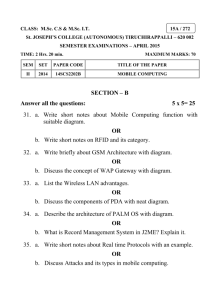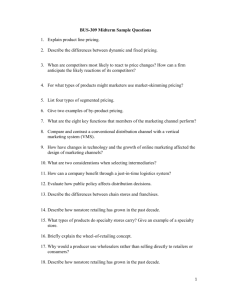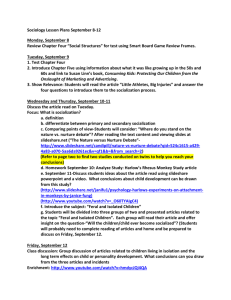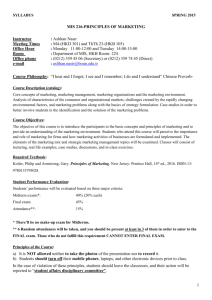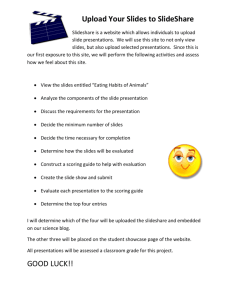Chapter 1 What is Marketing
advertisement
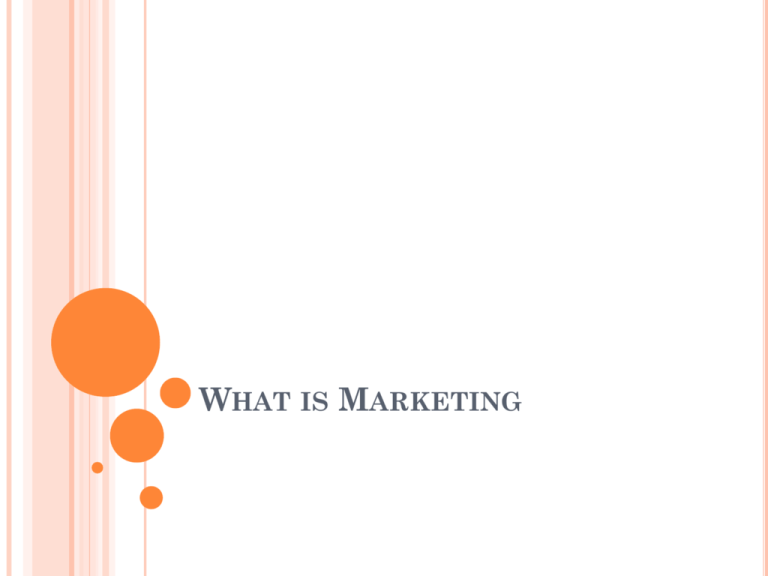
WHAT IS MARKETING MARKETING DEFINITION “Marketing” is the process of planning and executing the conception, pricing, promotion and distribution of ideas, goods, and services to create exchanges that satisfy customer and organizational objectives. CORE MARKETING CONCEPTS Needs, Wants & Demands Markets Core Marketing Concepts Exchange, Transactions & Relationships Products & Services Value, Satisfaction & Quality NEEDS, WANTS & DEMANDS Need - are part of the human makeup. Want - are formed by culture and individual personality Physical needs such as food, water, shelter; social needs for belonging and affection and individual needs for knowledge and self-expression Think – Maslow’s Hierarchy of Needs e.g., you may need food, but you want a hamburger and fries. But a person who lives in China may need food, but wants mango, rice and noodles. Demand - are human wants that are backed by buying power. pick products that provide value and satisfaction for their money. LOGO CHALLENGE Scenario #1:w.slideshare.net/kristinsexton/trademarks-logos-powerpoint Scenario #1: CREATE PRODUCT OR SERVICE To design a Product or Service Understanding customers needs, wants & demands through: market research, samples, observations, polls, databases, customer inquiries, and Customer service data DEFINING PRODUCTS Tangible Product- something you can hold, feel, taste and play. Examples – desk, chair, iPhone, etc. Intangible Products - can include items such as experiences, persons, places, organizations, information, and ideas. As consumers we might have our haircut, we pay for that service, but we don’t actually go around carrying it in a bag. You actually leave the store with less than when you came in!!! EXCHANGE, TRANSACTION & RELATIONSHIP Exchange - is the trading of something of value between a buyer and seller so that each is better off after the trade. Marketers must offer value, satisfaction and quality in their product or service to create an exchange. Relationship - Organizations must also create a relationship with that customer to create a transaction or exchange that will develop a market for that particular product or service. INTRODUCTION TO MARKETING Marketing is the sum of all the activities involved in the planning, pricing, promoting, distributing, and selling of goods and services to satisfy consumers' needs and wants. w.slideshare.net/kristinsexton/trademarks-logos-powerpoint INTRODUCTION TO MARKETING Marketing is more than just advertising and promotion. It basically covers all the activities that are required to get a product/service from the source to the customer (see p16/17) Research Product development Pricing Packaging Branding Sales Physical Distribution Inventory management Storage Promotion w.slideshare.net/kristinsexton/trademarks-logos-powerpoint MARKETING Marketing can be summarized by the 4P’s and 2C’s. Product/service Price Promotion Place Customer Competition MARKETING CONCEPTS "We offer you a means for gathering, processing, and analyzing business data." Firm B "We make computers.“ Firm A Firm A "Please donate blood. Your hospital needs it." Firm B "Please donate You will never know when you or one of your loved ones will need it.“ Firm A Firm B at the "We make pumps." "We deliver water into people's homes right pressure and volume." MARKET RESEARCH The systematic collection, analysis, and interpretation of information used to develop a marketing strategy or to solve a marketing problem. WHY DO WE NEED IT? Provides hard data Information based on supportable facts Use information gathered to make marketing efforts more successful Allows companies to better understand the needs and wants of customers Create new customer markets or better serve existing ones TYPES OF MARKET RESEARCH Surveys Focus Groups Taste Tests Product Research Customer Analysis Competitor Analysis 4P’S - PRODUCT 4P’S - PRODUCT Product/Service. They come from human invention or innovation. Inventions are radically new products/service – never seen before. Innovation are improvements to existing products/service. 4P’S - PRODUCT Products (goods) are tangible. They are physical (see and touch them). Examples? Services are non tangible. Example? However, both have value and are things that are exchanged. GOODS AND SERVICES Industrial goods – products used by other businesses to produce their products or to operate Consumer goods – products or services made for the general public (end user) 4P’S - PRODUCT Products/services have a life cycle just like we do; Introduction growth mature stage decline/death stage 4P’S - PRICE What price are you going to sell at? How do you determine the price? How will the price affect product sales and image? 4P’S - PLACE Where are you going to sell your product? Direct sales or intermediaries? Examples? What purpose do intermediaries serve? What are the implications of your decision? 4P’S - PROMOTION Promotion mix consists of advertising, sales promotion and publicity How are you going to convince people about your product? What, when, where, how are you going to promote your product. 4P’S - PROMOTION ACTIVITY #1 I. Choose a product/service. Research it and identify when it was invented and what were the circumstances that brought it into existence. II. Identify (at least 3) innovations for your invention choice. How have these innovations made it better? Explain. III. Identify the: Price – Product – Place – Promotion strategy 2 C’S:CUSTOMER (TARGET MARKET) The customer is the person who makes the purchase. The consumer is the person that consumes the product Are they the same person? 2 C’S - CUSTOMER First you need to know what the customer wants and/or needs are? Therefore you must determine who your customer is/or is going to be. You must determine the common characteristics of your customer You must inform, persuade, and convince the customer with respect to your product/service. 2 C’S - COMPETITION What products/service exists already? Who/what is your competition? How do you compare/differentiate your product/service from the competition? How do you stay a step ahead of your competition? MARKETING AND ORGANIZATIONS Companies can organize based on how they market Regional – West, central, Atlantic International – Asia, North America, Europe Brand – i.e. (Proctor and Gamble), Tide, Pringles, Folgers, Ivory soap Distribution – stores, hotels, airlines, vending machines ORGANIZATIONS There are two general types of organizations, profit based (businesses) and not-for-profit organizations PUSH/PULL STRATEGY Push – sells to wholesalers, importers and retailers but not end use consumers I.e. Candles - consumers see it they will buy it. Pull – Sell to the customer directly through promotion activities. ACTIVITY #2 I. Give an example where the customer and customer are the same in a purchase of a product? Give an example where the customer and customer are different? II. What is an industrial customer? III. What is profit? Why is it important consideration when determining a selling price? IV. What is a wholesaler? What is a retailer? V. Give example of products/services that are sold directly to the customer. VI. Provide example of marketing promotion. ACTIVITY #3 Brainstorm and think what a world without advertising and marketing would be like. List how people (consumers) would benefit from a world without advertisements and marketing. Then, list all the benefits that people get from advertisements and marketing. Hand in one extremely neat copy to the teacher for evaluation. Activity #4 Identify one consumer need. Identify one consumer want. Describe the marketing concepts by relating the 4P’s and 2 C’s to each one of your examples of a need and want. Recreate the table and providing at least 3 different points for each item. Hand in a neat copy for evaluation. Need Product Description Price Place Promotion Consumer Competition. Want HISTORY - MARKETING Businesses are profit-orientated organizations. They seek to make money (profit) from the marketing of their products/services. This is vital for their existence. Not-for-profit organizations still need money to operate; however, they are not motivated to make profits. Typically they provide services. Examples of not-forprofit organization include government, Red Cross, United Appeal, Salvation Army, Canadian Cancer Association etc…. ACTIVITY #5 Working alone or in pairs comes up with an example of a not-for-profit organization. Marketing is just as important for these organizations. Come up with examples of how the 4P’s and 2 C’s are relevant for your organization. Submit a neat copy of your work for evaluation.



